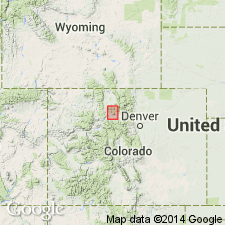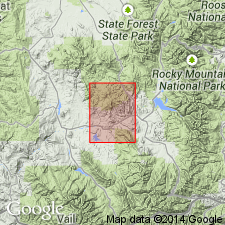
- Usage in publication:
-
- Pete Gulch Member*
- Modifications:
-
- Original reference
- Dominant lithology:
-
- Trachybasalt
- AAPG geologic province:
-
- North Park basin
Summary:
Pete Gulch Member, in lower part of Rabbit Ears Volcanics (new). Distinctive dark-gray to black, porphyritic trachybasalt flows. Thickness 0 to 200 feet. Near Pete Gulch, lower 70 feet of unit is polygonally jointed and overlain by about 100 feet of massive-weathering trachybasalt. Deposited on intensely eroded terrain cut on Middle Park Formation. Tentatively dated as Oligocene inasmuch as it overlies Middle Park Formation of Late Cretaceous and early Tertiary age and seems to be spatially related to upper part of the Rabbit Ears. Distinguished from the younger nonporphyritic basalt flows of Grouse Mountain Basalt by the large phenocrysts of pyroxene, flakes of biotite, and hornblende(?) ghosts.
Type locality: near Pete Gulch in secs. 4 and 9, T. 2 N., R. 79 W., Hot Sulphur Springs quadrangle, Grand Co., northwestern CO.
Source: Publication; US geologic names lexicon (USGS Bull. 1350, p. 569).

- Usage in publication:
-
- Pete Gulch Member*
- Modifications:
-
- Areal extent
- AAPG geologic province:
-
- North Park basin
Summary:
Is a distinctive unit of trachybasalt lava flows at base of Rabbit Ears Volcanics mapped (geologic map) on west edge of quad in Grand Co, CO in the North Park basin. Lavas are discontinuous. Ranges from 0 to 200 ft thick. Oligocene age determined from stratigraphic position. Rests unconformably on Middle Park Formation. Oligocene age.
Source: GNU records (USGS DDS-6; Denver GNULEX).
For more information, please contact Nancy Stamm, Geologic Names Committee Secretary.
Asterisk (*) indicates published by U.S. Geological Survey authors.
"No current usage" (†) implies that a name has been abandoned or has fallen into disuse. Former usage and, if known, replacement name given in parentheses ( ).
Slash (/) indicates name conflicts with nomenclatural guidelines (CSN, 1933; ACSN, 1961, 1970; NACSN, 1983, 2005, 2021). May be explained within brackets ([ ]).

